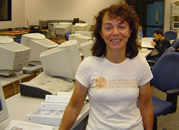
I am from Bulgaria where I got my Bachelor’s degree in Electrical Engineering with emphasis on Controls. I came to the U.S. in 1998 and I lived in the Washington, D.C. area before coming to Maui. I worked for Lucent Technologies for three years as a Quality Assurance/System Test for one of the Lucent’s telecommunications switches. My husband and I came to Maui in 2003 and I decided to take some courses at MCC to stay current in the technical field. I am interested in Electronics and would like to apply my technical skills and knowledge to work on environmentally sustainable technologies. My hobbies are hiking, biking, windsurfing and computer graphics.
Home Island: Maui
High School:
Institution when accepted: Maui Community College
Akamai Project: Sensor Test-bed for the High Accuracy Network Orbit Determination System
Project Site: Oceanit
Mentor: Ed Walker, Dan O’Connell and Maile Griffin
Project Abstract:
The purpose of the Sensor Test-bed for the High Accuracy Network Orbit Determination System (HANDS) project is to provide highly accurate orbit determination and tracking of geosynchronous (GEO) and deep space satellites. The HANDS sensor test-bed, built at the Oceanit laboratory, is used to evaluate different types of sensors for future implementation. Position Sensing Devices (PSDs) are photodiodes capable of finding or locating a beam within a defined sensing area. The PSD gives an output that is a function of the center of gravity of the total light quantity distribution on the active area, while a camera output contains information on the light quantity all over the active area and thus describes a picture. Experiments were performed with a Position Sensing Device (PSD) in order to quantify its performance in terms of temporal, spatial and power level sensitivity. The characteristics of the PSD were compared with that of Silicon Video 1281 Complementary Metal Oxide Semiconductor (CMOS) digital camera. The experimental results showed that the PSD provides higher sensitivity to position changes, larger dynamic light-range and faster equivalent frame rate compared to the camera. The main advantage of the camera is that it can detect the power level in order of picowatts versus microwatts for the PSD. In addition, it can provide visual information when multiple light spots are present on the detector. As a result of this testing it has been concluded that the PSD makes a good complement the CMOS camera and will add higher accuracy and faster response measurements.